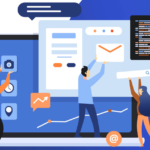Why do e-commerce sites need the right web designer and developer?
This is the perfect combo to keep your online store running smoothly while looking great and attracting customers. Let’s evaluate them separately. A web developer handles the back-end part, making sure all buttons work, pages load fast, and payments are secure. One click—fast reaction. Meanwhile, a web designer ensures your store is mobile-friendly and easy to navigate, so customers can shop hassle-free through their smartphones. Together, they’ll create an e-commerce platform that your customers will love and that’ll boost your business.
What specific e-commerce platform expertise?
For your platform to work for both your business and users, developers need the right expertise. Developers must possess a comprehensive understanding of platforms such as Shopify, Magento, BigCommerce, and similar ones. It’s about knowing how these platforms function, how payment systems integrate, how to set up SEO, how to manage product catalogs, and, of course, ensuring the security of personal user data. It’s a set of info that directs all the workflows.
It’s also a plus to know how the platform can scale in the future and be adapted to changing business needs. All of this is key to creating a platform that meets both business goals and modern customer expectations.
How to review a potential designer’s portfolio for UX and conversions
To make sure a web designer is the right fit for your project, take a look at the following in their portfolio:
- Check how easy it is for users to find the info or products they need. It’s a user journey option.
- Make sure the navigation is clear and works well across different devices. Like laptops, smartphones & tablets.
- See if the designs are mobile-friendly because it’s a must for 21st-century customers.
- Look at how the designer uses visuals to grab attention and keep users engaged.
- Make sure the design isn’t overwhelming and that important info is highlighted and in the right place.
- Check if there are any features for feedback or tracking user activity.
- See if the portfolio includes real tests and their results, along with any feedback or improvements after testing.
How does the developer test, debug, and ensure the site?
Let’s break down each process.
Test
The developer checks everything users interact with on the site—buttons, forms, clickable links, etc. The platform is also tested on different devices to make sure it displays correctly, loads fast, and makes it easy for users to take the desired actions.
Debug
At this stage, the developer fixes any code mistakes. If bugs pop up during testing or there are issues with functionality or speed, they are addressed and retested.
Ensure the site
Here, the dev checks the platform’s speed to ensure smooth operation without any freezes. The security is also verified to protect user data, particularly during orders. Lastly, the site is tested across different browsers and operating systems to guarantee consistent performance everywhere.
The key questions to ask regarding post-launch maintenance and support
Here are some questions to ask your web development and design provider to make sure you’re on the same page:
- How often will updates and bug fixes happen?
- Can we sign an SLA agreement?
- What’s the response time for technical support?
- How will you keep the site secure after launch?
- How will you track the website’s performance and effectiveness?
- Are there any extra costs for ongoing maintenance or improvements?
What red flags should I notice when interviewing potential candidates?
Typically, you can get a good feel for whether a candidate is right for the role. It’s clear by how they communicate and also after their portfolio review. But still, there are some red flags to watch out for in this process:
- The candidate can’t give examples of successful projects or solving complex problems.
- They lack an understanding of key technical aspects or the specifics of your industry.
- Poor communication skills or no experience working in a team.
- No desire to learn and grow professionally. That means he isn’t interested in the work he does.
Conclusions
The difference between a web designer and a web developer is that they work on different project parts but with common goals. There are a few key things to focus on when looking at potential web developers and designers. First, check their e-commerce expertise, past projects, and communication skills. This solid foundation will help you find people who can create stuff that works well, looks great, and keeps real value to users.









